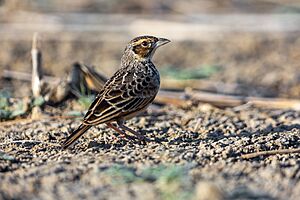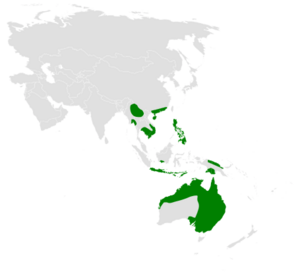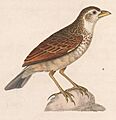Singing bush lark facts for kids
Quick facts for kids Singing bush lark |
|
|---|---|
 |
|
| Conservation status | |
| Scientific classification | |
| Genus: |
Mirafra
|
| Species: |
javanica
|
 |
|
| Range of Mirafra javanica chadensis | |
The singing bush lark or Horsfield's bush lark (Mirafra javanica) is a type of lark bird. It lives in grasslands across most of Australia and a large part of Southeast Asia. An American scientist named Thomas Horsfield first described this bird.
Contents
About the Singing Bush Lark
The singing bush lark is a small, sturdy bird. It has a big head, a short bill like a sparrow, and a small crest on its head. This crest only shows when the bird raises it.
Its back feathers are brown, reddish, or sandy, with darker stripes in the middle. Its chest has spots or streaks, and it has a pale eyebrow. The underside of its body is light, and its tail is brown. Adult birds have dark upper parts and a dark crown (top of the head) with rough, light brown or reddish streaks. Young birds look similar, but their crown and upper parts have neat, thin white edges on their feathers.
These larks are usually 61–81 mm long from wingtip to wingtip. Their tail is 40–56 mm long, and their bill is 12–16 mm long. They weigh about 18–25 grams. Their wings are short and round, with a clear reddish patch.
How to Spot a Singing Bush Lark
The bush lark looks a lot like the Australian pipit and can sometimes be mistaken for a young Eurasian skylark. However, there are ways to tell them apart!
When flying, the bush lark's wings do not have the white edge that the skylark's wings do. Its tail has white sides, like the skylark and pipit, but it is only half as long. You can often identify the bush lark by its shape and the reddish patches on its wings. These patches can fade to a lighter, buff color over time.
When a bush lark is startled and flies up, it makes a slurred chirping sound. Its flight is often jerky, with its head slightly raised and its tail pointing down. Before landing, it might hover or flutter briefly. In contrast, the Australian pipit stands more upright, is thinner, and has a more slender bill. It walks with purpose on its long legs. When standing, the pipit constantly bobs its tail. In flight, it drops into cover without hovering.
Where Singing Bush Larks Live
The singing bush lark lives in many places, covering a huge area of about 10,000,000 square kilometers! In Australia, you can find them from the Eyre Peninsula in South Australia, through Victoria, New South Wales, Queensland, the Northern Territory, and Western Australia all the way to Shark Bay.
These birds move to southeastern Australia for the summer. They sometimes visit the island of Tasmania. In Australia, they live in shrublands, native and non-native grasslands in warm and tropical areas, coastal heathlands, sand dunes, and mudflats. They also live in places changed by humans, like farms and pastures. You might see them less often on playing fields, golf courses, roadsides, salt marshes, or other shrublands. They rarely live in areas with many trees.
Life and Habits of the Singing Bush Lark
Reproduction and Life Cycle
In Australia, bush larks often breed after heavy rain in dry areas. During the breeding season, they protect their territory. Both parents help to incubate (sit on) the eggs and feed the baby birds (nestlings and fledglings). They also remove waste sacs from the nest.
Young birds stay in the nest for about 12–14 days or even longer. But if something disturbs them, they might leave the nest as early as 7–8 days old, even before they can fly well. They depend on their parents for almost a month after leaving the nest. Sadly, many nests do not succeed, often because of predators like introduced mammals.
In 1865, a scientist named Edward P. Ramsay wrote about how these larks built their nests. He said they usually built nests in November, December, January, and February. Their nests were loose and messy, made of grasses, and shaped like a cup. They would scrape a small hollow next to a clump of grass or behind a dirt clod to build the nest. The front edge of the nest was smooth, but the back was messy, sometimes pulled forward to hide the eggs. Nests were about 28 inches wide and 1 inch deep. He found a nest with three eggs, which was a common number. The eggs were light earthy brown with many darker freckles.
Singing and Sounds
During the breeding season, singing bush larks sing at any time of day or night. They sing from the ground, low perches, or while flying high over their territory. The bush lark can sing a beautiful, long song. It often includes amazing mimicry, meaning it copies the calls of many other bird species.
Someone in the 1930s noted that the lark might remember or "steal" calls from other birds. For example, it could imitate the "tink, tink" sound of the Brown treecreeper, even if that bird no longer lived in the area. This meant the lark either heard the sound during its travels or learned it from another lark that could mimic it.
What Singing Bush Larks Eat
Bush larks mostly stay on the ground and eat many different things (they are omnivores). They have a short, strong bill perfect for crushing seeds. They mainly eat grass seeds and small creatures without backbones, especially insects during the breeding season. They find most of their food by picking it up from the ground surface or just below it. They usually look for food alone, but sometimes you can see them in small groups.
Gallery




